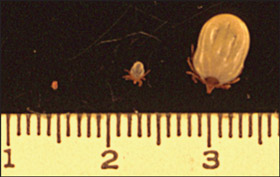Twenty-five patients living in a tick-endemic region of Sydney, New South Wales developed red meat allergy after experiencing large local reactions to tick bites. This represents a potentially novel cross-reaction between an arthropod and a food protein.
Between 2003 and 2007, 25 patients (seven men, 18 women; mean age [range], 29.9 [21–63] years) presented to our allergy practice in Sydney, New South Wales with a history of an allergic reaction to red meat.
All patients lived in the northern beaches region of Sydney, which is endemically infested with several tick species. Twenty-four of the 25 patients gave a history of large local reactions to tick bites, defined as the rapid or delayed onset of a painful, pruritic lesion greater than 50 mm in diameter that persisted for at least 1 week.1 They all stated that the organism responsible for their local reaction was a hard-bodied tick, based on the presence of an armoured shell (scutulum). They also provided an estimate of the tick’s size, which ranged from 3 to 10 mm, and recalled the shape as resembling that of a human fingernail. No patient reported a history of large local or generalised reactions to other bites or stings, such as those from honeybees, wasps or mosquitoes. The remaining patient did not report any reactions, despite having incurred multiple tick bites. In all but one case, tick exposure preceded the development of the meat allergy by 1 to 6 months. One patient’s onset of meat allergy preceded the tick bite by 6 months.
Patients’ IgE-mediated responses to red meat were confirmed by skin-prick test and/or fluoroenzyme immunoassay (ImmunoCAP, Phadia, Uppsala, Sweden). All patients had a positive result for at least one type of red meat; 22/25 (88%) had a positive reaction to more than one type (Box 1). There was no correlation between the wheal size on skin-prick testing or the amount of specific IgE detected by fluoroenzyme immunoassay and either the severity of the response to red meat ingestion or the size of the local reaction to the tick bite.
Based on our experience of 25 patients, we suggest a novel association between tick bite reactions and red meat allergy. We speculate that individuals are sensitised to tick salivary proteins that are cross-reactive with proteins found in various red meats.
Cross-reactivity between milk and beef,2 and between animal epithelia and meat,3,4 has been previously described, suggesting mechanisms of secondary sensitisation to meat. The association with reactions to tick salivary proteins may represent another such example. Anaphylactic and large local reactions to tick bites are IgE-mediated responses to tick salivary proteins.1
We infer that the species of hard-bodied tick most likely to be responsible for these local reactions is Ixodes holocyclus, commonly known as the paralysis tick (Box 2). I. holocyclus is not only the major species of tick found in the northern beaches region of Sydney that affects humans, but is also the species responsible for hypersensitivity reactions in humans.5 However, a skin-prick solution comprising paralysis tick antigens has not been standardised, and an in-house preparation carries a risk not only of anaphylaxis, but also of introduction of tick-borne disease; hence, there is currently no reliable, safe method of detecting IgE antibodies against I. holocyclus.
It is intriguing that none of our patients who developed red meat allergy had an anaphylactic reaction to tick bite. It is possible that different allergens are involved in IgE-mediated local reactions and anaphylaxis, and that the allergens involved in local reactions are also found in red meat proteins, or, alternatively, that the inoculated allergens are processed differently in different individuals. There may be poorer inactivation of allergens by mast cells at the local site in some individuals, resulting in a more prolonged immunological stimulus.6
Bovine serum albumin has been identified as a major allergen responsible for a number of cases of meat allergy.7 More recently, IgE antibody to galactose-α-1,3-galactose has been identified as a cause of anaphylaxis and delayed immune reactions to red meat.8 This molecule is also present in recombinant mouse-derived monoclonal antibodies, such as cetuximab, and a number of invertebrates, such as amoebae and worms.9 It remains to be determined whether such homologous allergens exist in tick saliva. An alternative explanation is simply that the transfer of animal allergens by the tick occurs in genetically predisposed individuals. Bandicoots, possums and dogs, rather than cattle, are recipients of bites from the I. holocyclus species of tick, and it is therefore possible that there are allergens with a high level of homology found within bandicoot, possum and various ingestible red meat proteins. Also, the possibility of cutaneous exposure as a route of sensitisation to food allergens has been postulated as a mechanism for the development of peanut allergy.10






None identified.